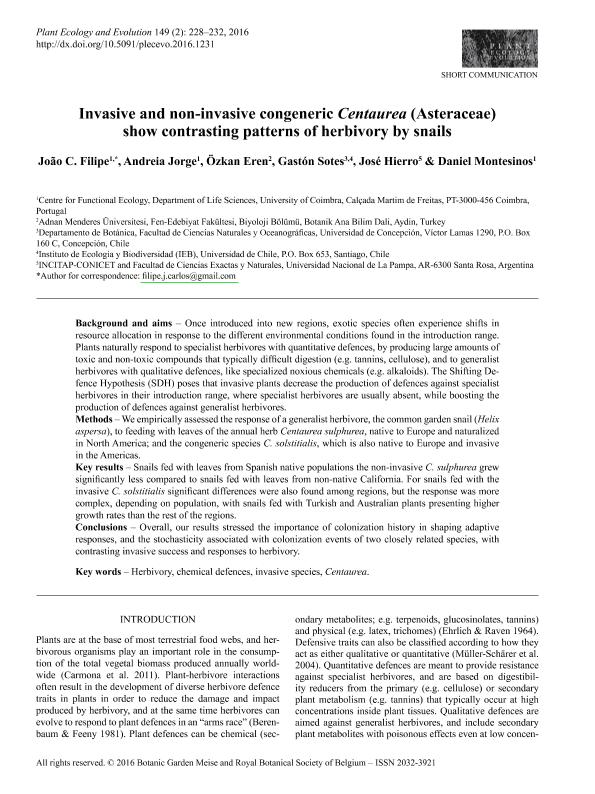Artículo
Invasive and non-invasive congeneric Centaurea (Asteraceae) show contrasting patterns of herbivory by snails
Fecha de publicación:
07/2016
Editorial:
Royal Botanical Society of Belgium
Revista:
Plant Ecology and Evolution
ISSN:
2032-3921
e-ISSN:
2032-3921
Idioma:
Inglés
Tipo de recurso:
Artículo publicado
Clasificación temática:
Resumen
Background and aims – Once introduced into new regions, exotic species often experience shifts in resource allocation in response to the different environmental conditions found in the introduction range. Plants naturally respond to specialist herbivores with quantitative defences, by producing large amounts of toxic and non-toxic compounds that typically difficult digestion (e.g. tannins, cellulose), and to generalist herbivores with qualitative defences, like specialized noxious chemicals (e.g. alkaloids). The Shifting Defence Hypothesis (SDH) poses that invasive plants decrease the production of defences against specialist herbivores in their introduction range, where specialist herbivores are usually absent, while boosting the production of defences against generalist herbivores. Methods – We empirically assessed the response of a generalist herbivore, the common garden snail (Helix aspersa), to feeding with leaves of the annual herb Centaurea sulphurea, native to Europe and naturalized in North America; and the congeneric species C. solstitialis, which is also native to Europe and invasive in the Americas. Key results – Snails fed with leaves from Spanish native populations the non-invasive C. sulphurea grew significantly less compared to snails fed with leaves from non-native California. For snails fed with the invasive C. solstitialis significant differences were also found among regions, but the response was more complex, depending on population, with snails fed with Turkish and Australian plants presenting higher growth rates than the rest of the regions. Conclusions – Overall, our results stressed the importance of colonization history in shaping adaptive responses, and the stochasticity associated with colonization events of two closely related species, with contrasting invasive success and responses to herbivory.
Palabras clave:
Herbivory
,
Chemical Defences
,
Invasive Species
,
Centaurea
Archivos asociados
Licencia
Identificadores
Colecciones
Articulos(INCITAP)
Articulos de INST.D/CS D/L/TIERRA Y AMBIENTALES D/L/PAMPA
Articulos de INST.D/CS D/L/TIERRA Y AMBIENTALES D/L/PAMPA
Citación
Filipe, João C.; Jorge, Andreia; Eren, Ozkan; Sotes, Gastón; Hierro, Jose Luis; et al.; Invasive and non-invasive congeneric Centaurea (Asteraceae) show contrasting patterns of herbivory by snails; Royal Botanical Society of Belgium; Plant Ecology and Evolution; 149; 2; 7-2016; 228-232
Compartir
Altmétricas




